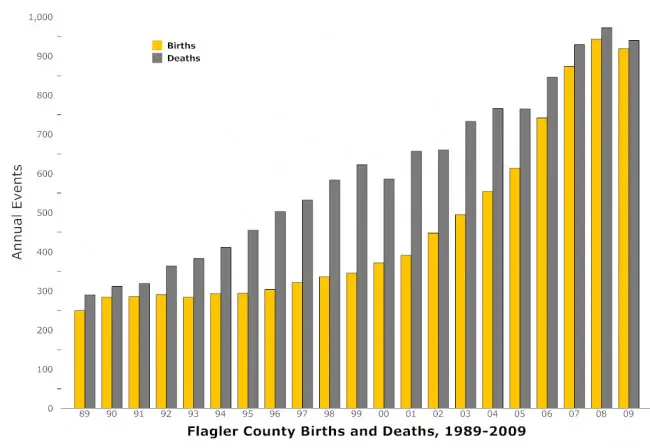
Flagler County’s old norms keep dying.
Used to be that property values never fell. And for more than two decades, they didn’t. They only increased. That changed in 2008, when they fell 8.5 percent, and kept falling more steeply the next two years. Values are set to fall again next year, if the last six months’ trends persist. Used to be that population in the county never fell, and year after year, for almost three decades, it only increased. The latest numbers from the Census Bureau show a decline in the last two years.
Click On:
- Palm Coast’s Population Drops to 69,000 in Latest Census Estimate, Flagler’s to 85,600
- Fact Check: How Forbes Got Palm Coast’s “Fastest-Growing City” Distinction Wrong
- Census: Flagler’s Population Stalls at 91,600; 28% of Housing Units Vacant; Poverty Rising
- Population and Demographics Data for Flagler County and Palm Coast, 2009 Census Bureau Community Survey
And it used to be that the number of births in Flagler County only increased. Year after year, since 1993 (when there were seven fewer births than the year before), Flagler couples have been particularly fruitful, tripling births in that 16-year span–until 2009, when births fell 2.5 percent, from 943 the previous year to 919. The number of deaths fell, too, from 972 to 940, though deaths, which have always outnumbered births in Flagler, took a dip three times in the last 20 years.
The trends aren’t restricted to Flagler. Last year births in Florida took their first dive since 1996, declining 2.2 percent. Year-over-year deaths in the state have declined in four of the last six years.
Why the declining births? “A combination of factors,” Flagler County Health Department Administrator Patrick Johnson says. “A lot of us think it’s economic. People don’t want to get pregnant if their financial status isn’t such that it makes sense.” There’s also been an exodus of younger, working-age people, who tend to be the baby-makers: as the economy soured, the construction, real estate and finance sectors collapsed, foreclosures exploded, and people left holding the bag often dropped it in place and left town. Half the county’s population is non-working, and the majority of that population is elderly.
That the incidence of death is decreasing doesn’t necessarily mean that the elderly are living healthier lives. That decrease is slight, and is likely accounted for by the overall decrease in the local population, particularly the non-elderly population: in a normal year in Flagler, about a quarter of all deaths happen to people younger than 65. As the number of people in that category migrates out of the county, so would, to some degree, the incidence of death overall.
Keep in mind as well that population trends nationally are slowing rather than accelerating. Figures released by the Census Bureau this month show the 2000s to be the slowest-growing decade, by population, since the 1930s. Florida’s population was among the fastest-growing despite recent trends (as also evidenced, of course, by Flagler ranking atop the fastest-growing counties, in rate of population increase, for several years during the decade), but the 9.7 percent increase in the national population compares with 13.2 percent in the previous decade, and is only a little higher than the 7.3 percent increase in the 1930s. A slow-down in immigration accounts for much of the lower rate.
Of the 919 births in Flagler County in 2009, 376 were to unwed mothers, 53 were to mothers 18 or younger (Flagler is among the counties with the lowest rates of births to teen mothers or unwed mothers in the state, but it is also among the counties whose youngest mothers are the least healthy by weight and by their infants’ weight), and one was to a mother who was between 10 and 14 years old. The county recorded four infant deaths.
The causes of death haven’t changed markedly in the county over the years, Johnson says.
The following two charts profile the causes of death in Flagler County in 2009 and, in more detail, how those causes compare with three other counties and Florida as a whole:

![]()

Source: Florida Department of Health, Office of Health Statistics and Assessment.





























Leave a Reply